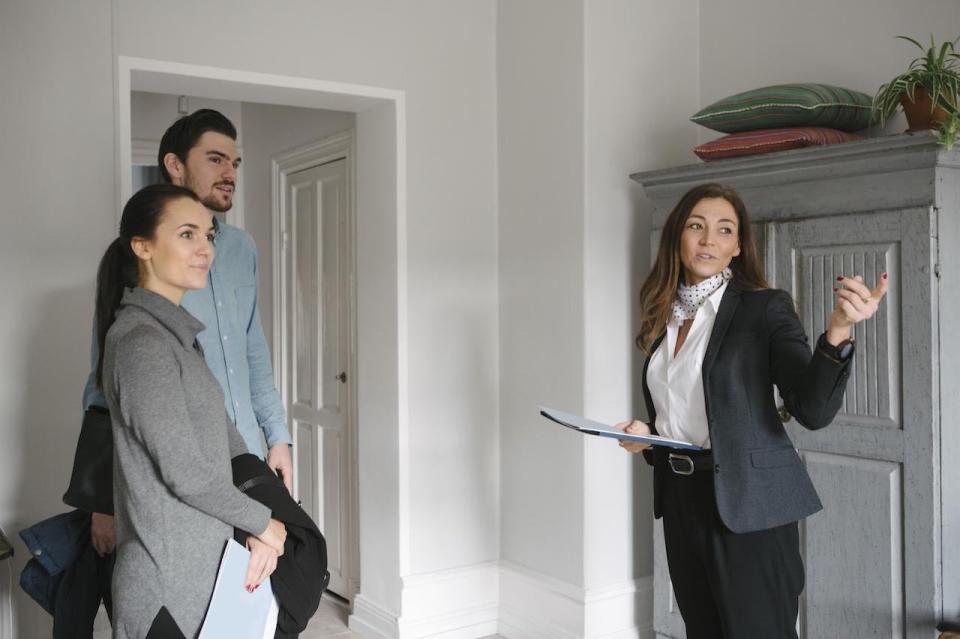A woman of property: Facts about women in real estate

Women have an illustrious history in the real estate industry — but it’s not a very long history. In fact, in the U.S., aspiring female homeowners weren’t even allowed to finance purchases on their own until the 1970s. Thankfully, women have achieved high levels of real estate–related success since then, both as homeowners and as industry professionals. Here are some of the most interesting stats, outrageous facts and impressive figures in the history of women in real estate.
Women in real estate facts and figures
[sc code="key_takeaways" headline_type="h2" takeaways_list="57% of all real estate brokers and agents are female; 50% of property, real estate and community association managers are women; 11% of construction industry professionals are women; 30% of architects are female; 88.5% of interior designers and decorators are women; 17% of single homebuyers are women; 10.76 million U.S. homes are owned and occupied by single women; Homes owned by women are worth 92.3% of male-owned homes; Female-owned homes generate 1.5% less in annualized returns than male-owned homes;" colors_variant="blue"]
History of women in real estate
Today, many women work in the home title industry. However, that wasn’t the case until the 1920s — in fact, when the American Land and Title Association (ALTA) was first established in 1907, it was called the American Association of Title Men. They changed that in 1923, and ALTA had its first female president in 2000.
The primary author of the Housing Act of 1937 (aka the Wagner-Steagall Act), which provided subsidized residences for low-income citizens for the very first time, was Catherine Bauer (1905-1964). An outspoken advocate of affordable homes for all — her book “Modern Housing” remains an oft-cited classic in the field — Bauer advised three different presidents and an array of federal agencies on urban planning for 30 years. The Wagner-Steagall Act made possible public housing developments like the Ten Eyck Houses in Brooklyn, New York (below).

Bettmann/Contributor/Getty Images
Relatively few women work in the field of construction: just 10.9 percent (and 9.9 percent in home construction specifically), according to the U.S. Bureau of Labor Statistics (BLS). Still, that represents a 52.9 percent increase in the last decade, from 840,000 women in 2013 to 1.28 million women in 2022. The first chapter of the National Association of Women in Construction was founded in 1953 by 16 women in Fort Worth, Texas. Today, NAWIC boasts more than 115 chapters all over the U.S.
Much has been made of the wage gap between men and women in the workforce, but in the field of construction, that gap is nearly nonexistent. According to NAWIC, female construction pros earn 95.5 percent of what the guys make.

Christopher Pillitz/Contributor/Getty Images
Women have more of a presence in designing buildings than constructing them: They represent nearly one-third (30 percent) of architects, according to the BLS. That’s only slightly up from 24 percent in 2004, when Zaha Hadid (above) became the first female to win the Pritzker Prize (architecture’s equivalent of an Academy Award). Still, the pace of progress may be quickening: The National Council of Architectural Registration Boards (NCARB) reports that 2 in 5 new architects are women — and that women consistently qualify for their licenses quicker than men, completing education, experience and examination requirements six months faster than the guys.

Bettmann/Contributor/Getty Images
When it comes to real estate interiors versus exteriors, the gender figures are flipped. An overwhelming 88.5 percent of interior designers and decorators are women. In fact, the person credited with inventing the field was female: Elsie de Wolfe (above, far right), an actress who in 1905 hung out a shingle styling herself a professional decorator. Big on light, patterned designs and soft, warm colors, she styled the homes of high society names like the Morgans, the Vanderbilts, the Fricks and the Duke and Duchess of Windsor.

Bettmann Archive/Getty Images
Three out of 17 Secretaries of the U.S. Department of Housing and Urban Development have been women. The first was Carla A. Hills, who served from 1975 to 1977, followed by Patricia R. Harris (above) from 1977 to 1979. Harris, who was also the first African-American woman appointed to the post, reformed the department, shifting its focus to fighting housing discrimination and funding the revitalization of inner-city neighborhoods.
Some 66 percent of all Realtors today are female. In 1908, when the National Association of Realtors was founded, that percentage was zero — the group was 100 percent male. The first woman was admitted to its membership in 1910, however, and by 1975, a third of its membership was female. NAR named its first female president in 1992; six women have held the post since.
A number of female real estate pros are famed in their field, such as Sherry Chris, CEO of several national realty firms, including Better Homes and Gardens Real Estate; billionaire mogul Jane Goldman, principal of Solil Management; and Christina Pappas, president of the Keyes Company, one of Florida’s biggest independent brokerages. Perhaps the best-known is Barbara Corcoran, founder of the Corcoran Group and one of the barracuda judges on the hit TV series “Shark Tank.”
Before 1974, women often were not permitted to obtain a mortgage without a male cosigner. Today, women actually outpace men in homeownership: 17 percent of today’s single homebuyers are women, compared with just 9 percent men, according to NAR. In fact, single women have bought more homes than single men every year since at least 1981.
An equality gap exists in the field of mortgage lending. According to a 2021 study by mortgage startup Own Up, women pay more for their mortgages in 49 of the 50 U.S. states (here’s to you, Alaska!). Despite having to pay more for their mortgages, single female borrowers default less than their male counterparts, and in general do a better job of paying off their loans, according to an Urban Institute research report.
Single women represent a bigger percentage of homeowners in all states except North and South Dakota: 10.76 million U.S. homes are owned and occupied by single women, while 8.12 million are owned and occupied by single men, according to U.S. Census Bureau data.
On the downside, homes owned by women tend to be worth less overall than those owned by male-headed households — specifically, worth 92.3 percent of male-owned homes, according to Zillow data.
Women pay approximately 2 percent more for housing compared to men and sell for 2 percent less, according to a Yale University study entitled “The Gender Gap in Housing Returns.”
That translates to single men earning 1.5 percent higher returns per year on their home investment relative to single women (8 percent higher if they’ve financed with a mortgage). The difference adds up to approximately 30 percent of the overall gender gap in wealth at retirement age, the study concludes.
Important women in real estate today
Name | Title | Organization |
|---|---|---|
Susan Daimler | President | Zillow |
Nadia Evangelou | Senior Economist & Director of Real Estate Research | National Association of Realtors |
Daryl Fairweather | Chief Economist | Redfin |
Marcia L. Fudge | Secretary | U.S. Department of Housing and Urban Development |
Selma Hepp | Chief Economist | CoreLogic |
Jessica Lautz | Deputy Chief Economist & Vice President of Research | National Association of Realtors |
Neda Navab | President | Compass |
Susan Wachter | Professor of Real Estate and Finance/Co-Director | University of Pennsylvania’s Wharton School/Penn Institute for Urban Research |
FAQs
When were women allowed to buy property?
Single women could own property under certain circumstances, but married women in the U.S. couldn’t buy or own property in their own name until the mid-1800s; everything belonged to their husbands, even inheritances. That began to change in 1848, with the passage of the Married Women’s Property Act in New York, which ensured the holdings a woman brought into a marriage remained her own. Other states followed suit. The Homestead Act of 1862 governed land ownership in the developing western territories and allowed any household head — without reference to gender — to gain title to a piece of raw land and develop it. By 1900, married women were allowed to own property in their own name in virtually the entire country. But they weren’t allowed to finance a purchase on their own until the 1970s.
What year could women get a mortgage?
In the U.S., 1974 is often cited as the year of women’s mortgage liberation. Before then, it was technically legal for financial institutions to refuse loans to unmarried women, or to require them to have a male co-signer. Likewise, a married woman often couldn’t apply on her own; she had to have her husband’s permission. Such practices were outlawed by the passage of the Equal Credit Opportunity Act in 1974, which prohibits discrimination against a loan or credit applicant for reasons related to sex, marital status or familial status (as well as race, religion and other reasons).
What year could women open a bank account?
In the past, women could often establish bank accounts in their own name only if they were single, divorced or widowed, and even then they needed a male co-signer. Most married women couldn’t open their own accounts without their husband’s formal approval. In the 1960s, banks began to loosen these rules, particularly for single women, who were entering the workforce and earning money in record numbers. But it took the Equal Credit Opportunity Act in 1974 to make it illegal for female applicants to be treated differently from males.
[sc code="alpine_collapse"]
